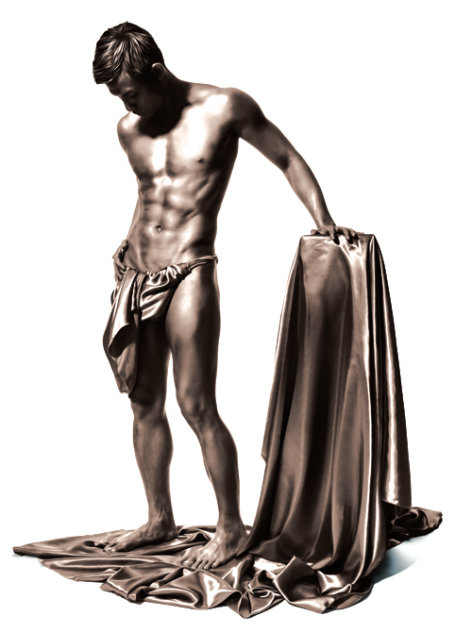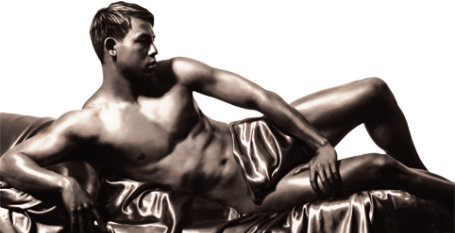This article previously appeared in Time Out Hong Kong
Hong Kong has never been so dominated by the ripped abs of buff men, by pecs of steel adorning 60ft billboards and shirtless adonises, proudly displaying their V-lines. In the past few years, we’ve seen an incredible change in the extent to which Asian men are becoming highly sexualised objects of desire, resulting, today, in a constant, hot barrage of unashamedly in-your-face torsos, of body-proud stars like Eddie Peng and Wu Chun, of the phenomenon of the topless ‘sunshine boys’ – those healthy, cut, sporty pinups becoming increasingly common in Hong Kong. Make no mistake, the era of the Asian sex symbol has begun.
Hong Kong has never been so dominated by the ripped abs of buff men, by pecs of steel adorning 60ft billboards and shirtless adonises, proudly displaying their V-lines. In the past few years, we’ve seen an incredible change in the extent to which Asian men are becoming highly sexualised objects of desire, resulting, today, in a constant, hot barrage of unashamedly in-your-face torsos, of body-proud stars like Eddie Peng and Wu Chun, of the phenomenon of the topless ‘sunshine boys’ – those healthy, cut, sporty pinups becoming increasingly common in Hong Kong. Make no mistake, the era of the Asian sex symbol has begun.
It might seem the norm in today’s world that men are as publically sexually desired as women – yet in Hong Kong, this wasn’t always the case. In fact, it’s a rather modern phenomenon that has really only come of age in the last few years. Let’s be clear, though: desirable Hong Kong men have long existed, but they’ve generally taken a different form. There was the dapper, charismatic gent, epitomised by Tony Leung Chiu-wai. Or the pretty boy-next-door, as Nicholas Tse and Edison Chen were back in their early 20s. But arguably never before have representations of men in Hong Kong been so provocatively, openly sexual.
It’s been a shift that has gradually occurred over the space of the last few years, with a growing line of rugged models and celebrities teaming up with beauty centres and fashion brands. Actor Nick Cheung went through a big buff change for the movie Unbeatable, singer Louis Cheung beefed up to be a spokesperson for Dr Schafter’s fat burning cream, while singer and actor Alex Fong became spokesperson for underwear and skincare brands. Their bodies have become a commodity, in many cases revitalising their careers.
Yet if you were to look for one moment where this evolution crystallised into a full-blown phenomenon, it would be hard to go past August 2012, when Abercrombie & Fitch launched its flagship store in Central, bringing with it a parading horde of ripped half-naked men. Social media was a frenzy. Passers-by waved from the street as a double decker bus-load of the models went past. And despite the hilarious, excessive kitsch of it all, there also radiated a feeling that girls wanted to have and date them and guys wanted to look like them.
Following the sunshineKing Chiu (pictured above and below) was one of the A&F models – and since then, he has become one of the most high-profile Hong Kong sex symbols, and perhaps epitomises the so-called ‘sunshine boy’ phenomenon of sporty, buff guys. “The change in my career certainly came from working at A&F,” says Chiu. Following the A&F launch, Chiu released King of V-Line, a provocative photo album of V-lines (those groin-topping muscles in the shape of a ‘V’) and buttocks, leading to his seemingly self-proclaimed nickname, ‘King of V-Line’. His photo book, along with books by two other male models, sold out at last year’s Hong Kong Book Fair and generated the kind of newspaper headlines usually reserved for their female counterparts. Suddenly, it was all about the boys.
“During my seven years of modelling, I never had to take off my shirt as much as I did after A&F came,” says Chiu. “After that, I’ve definitely taken up more fitness modelling jobs and I’ve noticed more opportunities for male models and celebrities.”
“A&F caused a social media frenzy that just rippled across the city,” Chiu continues. “It’s not like people didn’t like pecs and six packs before… but now they feel like they are allowed to like them openly. It really has been because of the brands and the influence of these companies that have affected the way people think.”
Significantly, as Chiu suggests, perhaps the most remarkable change has come in the way consumers have embraced the prospect of such highly sexualised male imagery. And according to Geng Song, an associate professor at the University of Hong Kong, who focuses on media and cultural studies, it has largely come from two factors.
“The major change is consumer discourse and the second wave of empowerment of women,” says Song. “Fashion labels and skincare brands with their advertisements have constructed an idea that men should look a certain way. So men look at those images and they think that should be something to aspire to. Surprisingly, for the past few years, a growing audience in China for magazines like GQ, Esquire and Men’s Health has actually been women. They want to see male bodies. So there has been a creation of supply and demand.”

A culture of v-line
Like many current cultural shifts, South Korea – and their dramas featuring strapping, handsome male leads and gratuitous shower scenes – has certainly played its part in Hong Kong’s new penchant for men. But it’s also been driven by a lot of other media and pop culture. Just last year, Apple Daily started a lifestyle page called The Most Handsome For Today, which features a different sporty young man each week talking about their daily fitness regimen and future career aspirations – suggestive poses ensue, as does the cheese. Male beauty pageants have sprouted up, and two new men’s focused publications – Elle Men Hong Kong and Esquire Hong Kong – have entered the market, taking the number of such lifestyle magazines to six. Edwin Ma is associate publisher of men’s lifestyle title MRRM. “Not only are there more men’s publications now, but they have indeed become more liberal in showing off more sexualised Asian male images,” says Ma. “We are providing a dream environment to our readers. Nowadays, sexuality does not only apply to ladies, but it also applies to men.”
And this demand that Song refers to has been very much driven by your average consumer. “I love sunshine boys, I always have,” says Bonnie Cheung, a 26-year-old fan of Chiu and his sunny colleagues. “These days it’s all about guys pulling their pants far down enough so we can see their V-line. I’m shy to admit it, but I do like it. V-line! V-line!” Connie Wong, 25, adds: “For me I think maybe I was influenced by Korean dramas, which usually have the schoolboy type or the masculine manly type. For me, I like the masculine type – if they have facial hair like Godfrey Gao, that’s actually quite a turn on as well.”
The role of girl powerIt’s precisely these kinds of statements from the general public that represent what Song refers to as the ‘empowerment of women’. “For women, beauty was their fortune,” says Song. “There has traditionally been a body and mind dichotomy between men and women. Women used their bodies and beauty for power, while men were supposed to rely on their mind. That, of course, has changed and is still changing. Women are independent now and though there is still salary inequality, women are earning more than they did in the past. And with this gradual shift in gender power, we see more overt female appreciation of male sexuality.”
It’s a sentiment with which celebrity model and founder of agency ModelOne, Ana R, agrees. “I don’t think that some of the Asian women had the confidence to talk about this stuff before,” she says. “But now, since women earn more and are taking up more leadership roles than before, they feel confident about sitting with their girlfriends like they do in Sex and the City to talk about guys. On the flip side, from being the judge on ATV’s Mr Asia Contest this year, for the first time in a long time, I’ve seen Asian guys look more masculine. You can see that there is a little bit more strength behind them. And I think before, they didn’t have that, maybe because they were shy. But now I feel a confidence. People are looking for an Asian male role model who has both brains and body.”
Besides consumer demands and the empowerment of women, MRRM’s Ma suggests another reason behind the rise of the Hong Kong sex symbols – a liberal shift in society’s attitudes toward sex and sexuality. “The increasing acceptance of homosexuality has given a liberal standpoint on sexuality,” he says. “By doing so, it takes away the stigma associated with men wanting to be desired.”
The desire to be desiredMa raises an important, distinct point about the modern man – that while there has been a significant growth in male sex symbols, there has also been an emphatic rise in the number of male consumers who want to be desired, who strive for V-lines, abs and pecs.
Mence Tsoi, the owner of successful beauty centre Mence Skin Care and Body Toning Authority, has noticed a substantial change in her business in the past half-decade. “At first, our clientele consisted of middle-aged men that just wanted to get rid of their bellies. Now we have a large, young demographic who come in to get abs,” she says. “I believe women are becoming pickier these days and that’s why men here need to up their game. Women watch Korean dramas and have certain expectations of how men can look.”
Chiu also agrees that men generally have a higher physical expectation for themselves. “I’ve always been into sports, but then that progressed into wanting to get fit, bigger and having a good body shape,” says the King of V-line. “I think it’s less about trying to necessarily attract others, but it is about building your own confidence and feeling attractive. It’s not like you can show off your abs all the time. Looking good and working out improves your overall health and general outlook on life, which I think is good for society as a whole.”
Social media outlets like Instagram and Facebook provide opportunities for these men to show off, feel good about themselves and get noticed without being laced with the shame they might have once felt. This, combined with the current ever-presence of provocative brand advertisements and media endorsements, and a new demand for such sex symbols for the public to idolise, has created a growing cycle that shows no sign of abating. In short, the men in this city are expecting more from themselves and women are expecting more from them as well. And those expectations, for better or worse, look like they’re here to stay.
Model: King ChiuMake up artists: Wing Cheung and German Cheung












 Printable Version
Printable Version















